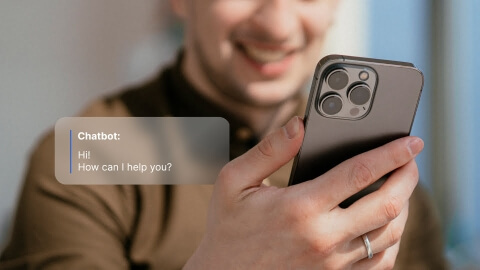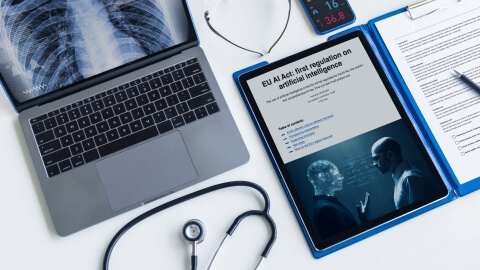Disruptive innovation in healthcare has already transformed the medical processes and treatment approaches, providing patients with tailored therapies and predicted outcomes.
Healthcare digitalization keeps evolving, introducing new technologies and digital solutions that aim to reshape the industry significantly. What are these technologies, and what benefits do they introduce in the domain? Keep reading to learn this and other insights into healthcare digitization.
What is a disruptive innovation in healthcare?
Disruptive innovation involves adopting modern technologies into healthcare processes. It aims to improve the quality of medical services, patient experience, and treatment outcomes, as well as advance personalized treatment and remote health monitoring capabilities.
Unlike other domains, the healthcare industry is demanding when it comes to the development of medical software and devices that will be used for patient monitoring, diagnosing, and treatment.
Let us further explore the role of disruptive innovation in healthcare and dive into the most outstanding disruptive innovation examples in healthcare.
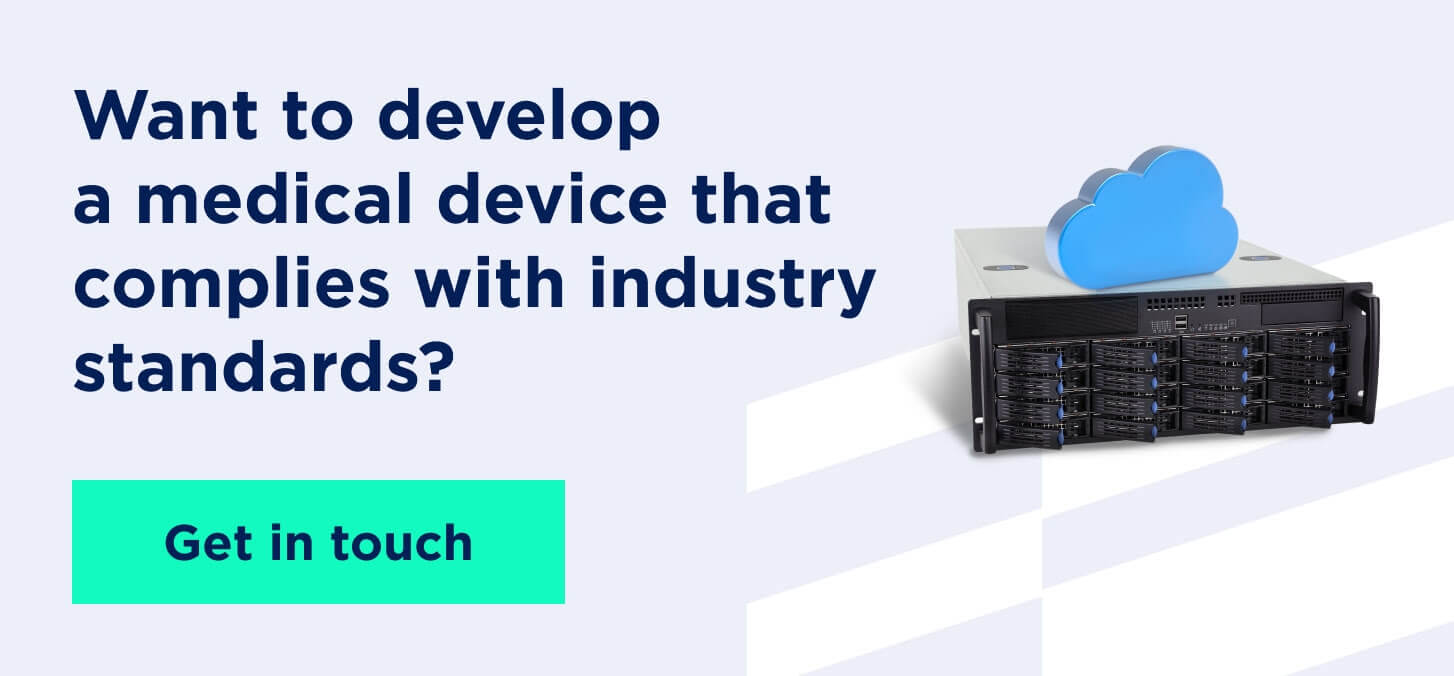
What role does technology innovation play in healthcare?
Nowadays, startups and well-established businesses are trying to introduce hundreds of digital innovations within the healthcare industry. These solutions commonly make standard medical procedures and treatments quicker, more efficient, and more affordable. Moreover, such solutions aim to automate routing processes in healthcare facilities and decrease medical staff workloads.
From one point of view, all these options benefit the healthcare units, patients, and the industry overall. On the other hand, developing and launching new medical devices in the market is very complicated for two main reasons:
- Medical device development requires following industry regulations and standards; moreover, it must be certified and approved for usage by assigned official organizations.
- Businesses that produce medical equipment, devices, or services are afraid of competition with disruptive technology in the healthcare industry. Some manufacturers may be left behind due to their inefficient legacy solutions or outdated approaches to development.
Eventually, developing, certifying, and launching a new medical solution is a long-term process, and many barriers exist from industry regulations and medical device providers in the market.
Further, we will examine the benefits and examples of disruptive innovation in healthcare and how they evolve, making medical services more available for a broader population and more precise for each patient.
Benefits of disruption innovation in the healthcare sector
Let's now examine the advantages of implementing tech advancements into healthcare processes.

- Enhanced patient care
Healthcare disruptive innovation takes patient care to a significantly higher level. Overall, all technologies used in healthcare units aim to provide patients with a better experience, treatment, and outcomes.
Healthcare tech innovation allows clinicians to provide patients with personalized treatment plans, accurate diagnoses and prescriptions, and remote health monitoring. The range of diseases that can be tracked remotely keeps developing as the number of medical devices in the market extends by over 6% annually.
- Automation of administrative tasks
Implementing technologies helps healthcare providers eliminate redundant administrative tasks and focus more on patient care. It usually entails the digitalization of health records, easy access to each patient's medical data, and decreased probability of human errors in health records, treatment, or prescriptions.’
Healthcare software systems like patient portals also simplify appointment scheduling, providing patients with a schedule relevant to their physicians and access to their drug prescriptions and medical records.
- Streamlined healthcare processes
Technologies connect all medical services and processes into a single network that patients and physicians can easily access. Such a network comprises patient management software like electronic health records, including their medical histories, lab test results, treatment, and medication prescriptions. It may also include patient portals, mobile apps, medical wearable devices, hospital management systems, virtual assistants, etc.
Eventually, healthcare digitalization automates routine tasks, provides quick access to the whole medical history of each patient in one place, reduces the probability of manual errors or data loss, and saves time and costs by lowering workloads from medical staff.
Disruptive innovations in healthcare: examples and case studies
Stay tuned to learn more about modern technologies that reshape medical services and the impact of disruptive innovation on the industry.
Artificial intelligence
Artificial intelligence (AI) reveals massive potential in the healthcare domain, introducing many opportunities and use cases to improve patient treatment, make it personalized, and predict treatment outcomes.
More and more healthcare facilities are seeking efficient AI solutions to meet their needs. Along with enhancing patient treatment, they struggle with staff shortages and overwhelming workloads. They strive to make accurate tests and diagnoses and provide quick results, especially for developing complex diseases.
Developing and implementing machine learning algorithms allow physicians to process large volumes of health data in the short term, ensuring its high-level accuracy. Thus, they can forecast the optimal treatment and medications explicitly customized for each patient.
Read also our recent article about AI regulation for developing medical devices in the EU.
Robotic surgery
Robotic surgery has been widely used in healthcare for the past four years, particularly in orthopedics, neurology, urology, and other fields. The adoption of automated medical instruments keeps growing due to the rising demand for special surgeries andthe shortage of experienced staff
Surgical robots assist physicians during surgeries, ensuring high accuracy, visibility, and control of each action. Moreover, some robots allow surgeries that are very complex or practically impossible to do with human-only intervention. In addition, surgical robots minimize invasion into the human body, reducing the level of stress for patients and making post-surgery recovery faster and easier.
Telemedicine
Telemedicine combines medical devices and systems designed to provide remote patients with sufficient consultation, health monitoring, electronic nursing for remote health control, and quick reactions to abnormalities. It also eliminates the need for often in-person visits.
Here is how it works: patients get medical wearables and other devices that ensure uninterrupted and real-time remote data collection via integrated sensors. These devices communicate with each other and central healthcare systems using connections like BLE, Wi-Fi, or Ethernet, transmitting patient data to physicians.
Telemedicine introduces many benefits for patients and medical facilities, including improved medical services tailored to each patient's needs, reduced physician workloads, timely symptom checking and diagnosis, and digital health data storage, access, and management.

From our background in developing telemedicine solutions, we want to share our collaboration with TCC, a German digital solutions provider for healthcare units. The initial goal of this project was the development an electronic nurse prototype to remotely monitor and measure patient health indicators and generate therapy based on revealed symptoms. Uncover more about our cooperation by reading the case study on our website.
Internet of Things
IoT has rapidly evolved in the healthcare sector since 2020, when COVID-19 hit the world. It got a specific title called the Internet of Medical Things or IoMT, with annual growth of over 21%.
The primary purpose and benefit of IoT in healthcare is to create a single network of interconnected medical devices and applications to collect, exchange, and store patient health information (PHI) over the Internet. It helps implement efficient remote patient monitoring, automate routine tasks, reduce workloads from medical staff, and convert all medical papers into digital data with managed access.
Regarding our experience delivering healthcare projects, IoT-based solutions occupy most of these cases. One of them is developing a medical device for cough sound recognition and comparing the received data with historical data regarding the same symptoms.
As a part of this project, our embedded development team created a device architecture and developed and integrated embedded software, including back-end and cloud functionalities. Learn more about the specifics of medical device development by following the link.
Digital twin
A digital twin is the exact digital copy of a physical object with all its components and attributes. It can be a human organ, sample population, hospital environment, or drugs
A digital twin is a virtual simulation used for different medical purposes, such as:
- A digital twin of the human body helps provide all required procedures and lab tests to diagnose the patient accurately, oversee disease development, and select the most personalized treatment plan, medications, and procedures.
- A digital environment of the healthcare unit helps assess and optimize internal resources and processes, such as staff management and workload allocations, inventory management, and process coordination, to improve patient care.
- Surgery simulation allows physicians to simulate complex clinical interventions before the actual procedure, double-checking the instruments and other options they need to consider to prevent any risks.
3D bioprinting
3D bioprinting is picking up steam in healthcare, caused by the rise of clinical research and trials for organ regeneration, skin tissue engineering, drug discovery and development.
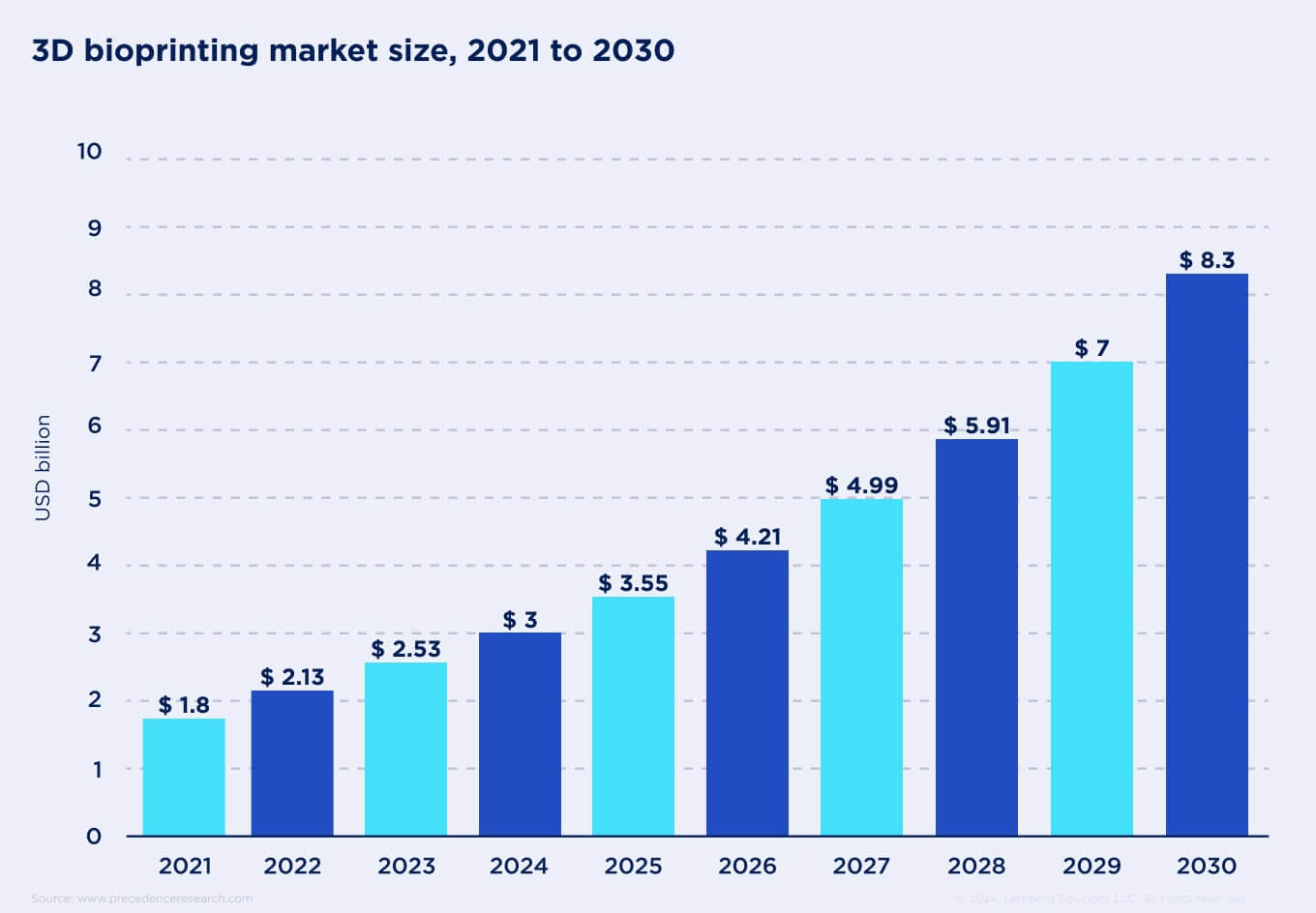
3D bioprinting revolutionizes organ transplantation. There are thousands of patients on the transplant waiting list, and the statistics are inconsolable. Over 5600 people waiting on the list die every year due to the lack of organs available for transplantation.
Instead, 3D bioprinting can significantly change the situation by regenerating capabilities. It combines living and 3D-printed cells, building structures similar to natural ones. This means that mixing patient and printed cells has massive potential in organ and tissue regeneration for timely transplantation and saving more lives.
As a healthcare software provider, we developed embedded software for Cellink's 3D bioprinters. The company deals with producing biomaterials and bioprinters to enable the creation of organs and tissue for transplantation.
During our collaboration, we made the organ 3D models more convenient to examine. We developed and integrated new features, polished existing system code, and improved the customer web portal. Follow the link to learn how the development process was happening.
FAQ chatbots
Healthcare is one of the industries that has significantly adopted FAQ chatbot usage. Regardless of the disease, patients often require round-the-clock support from clinicians, but as for clinicians, it is impossible to be in touch with each patient 24/7.
Medical FAQ chatbots may have many options, from scheduling appointments to remote health monitoring and notifying physicians of abnormalities. To name a few FAQ chatbot options and benefits they provide to medical services, these are:
- Online appointment scheduling – it makes in-person hospital visiting and phone calling unnecessary; patients can easily select the day and time available and convenient for their doctor appointment.
- Symptom checking – if patients recognize initial symptoms, they can find any related information in a chatbot data set and share this information with their physicians.
- Patient education – as FAQ chatbots have an integrated knowledge base, patients can search for medical information related to their disease or symptoms to decide on the next steps.
- Retrieval of healthcare locations – if patients are looking for local pharmacies or the closest hospitals for a doctor visit, they can search this information using a chatbot to see relevant results.
- Mental health support – patients may struggle with different mental problems during treatment, and chatbots can provide them with efficient, relaxing exercises to cope with anxious thoughts or panic attacks.
Blockchain
Blockchain is a thriving healthcare trend that has grown considerably over the past four years. By 2030, the investment in integrating blockchain technology among healthcare facilities will be up to 63,3%.
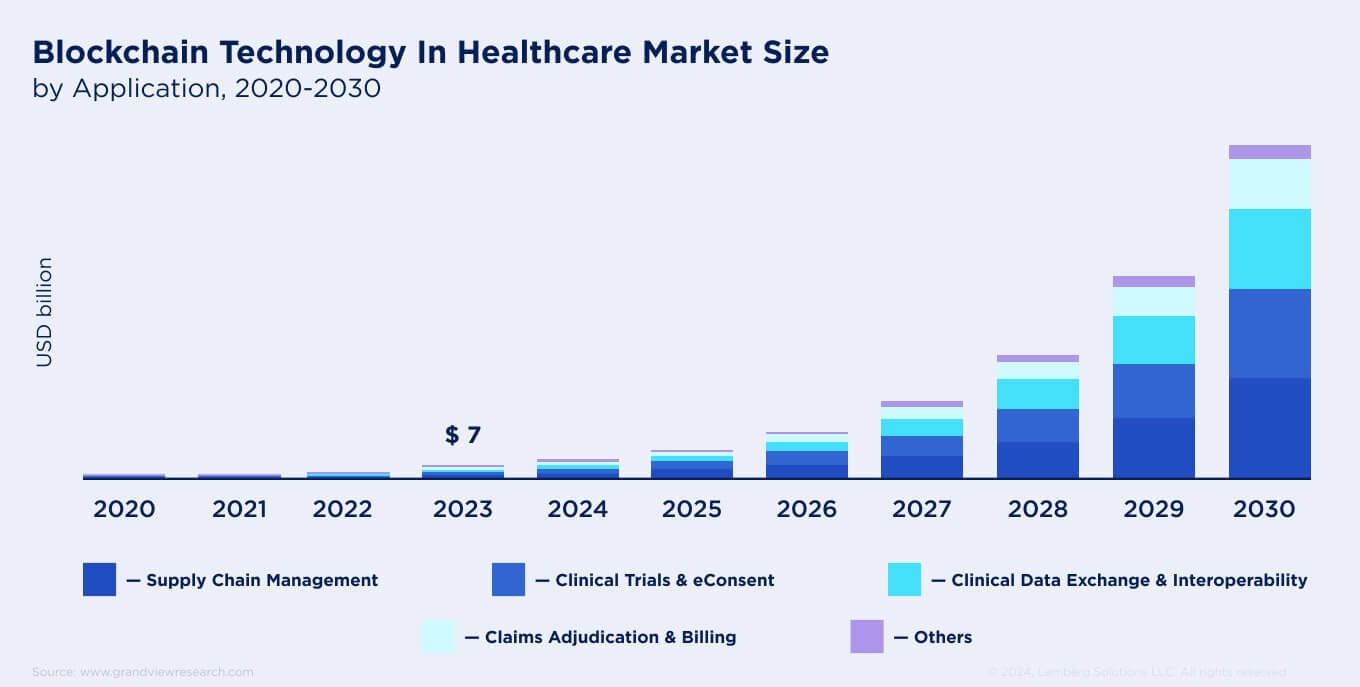
Blockchain networks ensure a secure and accurate exchange of patient health information within a centralized healthcare system that unites hospitals, laboratories, pharmacies, and other units.
Blockchain creates a single network that provides stable interaction between patients and medical facilities – medical devices, healthcare data management systems, hospital management solutions, drug stores, medical laboratories, and insurance companies.
Thus, the risks of healthcare data leakage, confusion, or loss significantly decrease, making it transparent. Only authorized parties can access data stored within the interconnected systems with different access levels and personalized credentials.

Wrapping up
Once you decide to start medical device development, hiring a trusted healthcare development services provider is crucial. The process of healthcare solution development is complex and requires adhering to industry standards depending on the type of product you want to build.
As an ISO 13485-certified company, we ensure compliant development of medical devices, following healthcare regulatory standards like ISO 14971, which manages risks for healthcare projects, and IEC 62304, which determines a step-by-step development life cycle.
If you have any questions about how we provide the healthcare development process and how to start your medical device development, fill in the simple form so we can process your request and propose the next steps.

